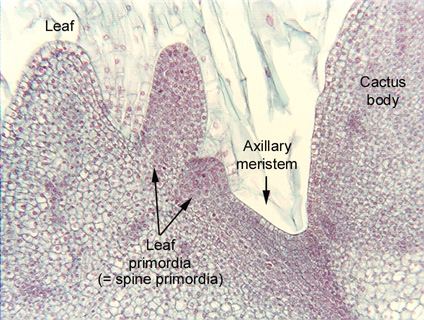 Fig. 6.1-5.
Longitudinal section of an axillary bud of a cactus (Oroya depressa). The
mass of cells on the right is the stem of the cactus body; in the center of the
micrograph is a flat surface that angles upward to the left, ending in a bump:
the flat region is the axillary meristem (or the
axillary bud apical meristem)
and the bump is a new leaf primordium. The taller bump to the left is an older
leaf primordium and the leftmost wide, dull bump is the leaf that makes the axil
in which this axillary bud occurs. Because this is an axillary bud, we would
expect the leaf primordia to develop into bud scales, but in cacti, they develop
into spines instead. Neither leaf primordium (or you can call them spine
primordia also) is old enough for any of their cells to start developing into
fibers. At this point, all cells produced by cell division continue to be
meristem cells, so the meristem itself becomes larger; once it achieves a
certain size, the uppermost cells will stop dividing and begin elongating,
establishing two zones: a spine basal meristem and a zone of
elongation/differentiation.
Fig. 6.1-5.
Longitudinal section of an axillary bud of a cactus (Oroya depressa). The
mass of cells on the right is the stem of the cactus body; in the center of the
micrograph is a flat surface that angles upward to the left, ending in a bump:
the flat region is the axillary meristem (or the
axillary bud apical meristem)
and the bump is a new leaf primordium. The taller bump to the left is an older
leaf primordium and the leftmost wide, dull bump is the leaf that makes the axil
in which this axillary bud occurs. Because this is an axillary bud, we would
expect the leaf primordia to develop into bud scales, but in cacti, they develop
into spines instead. Neither leaf primordium (or you can call them spine
primordia also) is old enough for any of their cells to start developing into
fibers. At this point, all cells produced by cell division continue to be
meristem cells, so the meristem itself becomes larger; once it achieves a
certain size, the uppermost cells will stop dividing and begin elongating,
establishing two zones: a spine basal meristem and a zone of
elongation/differentiation.